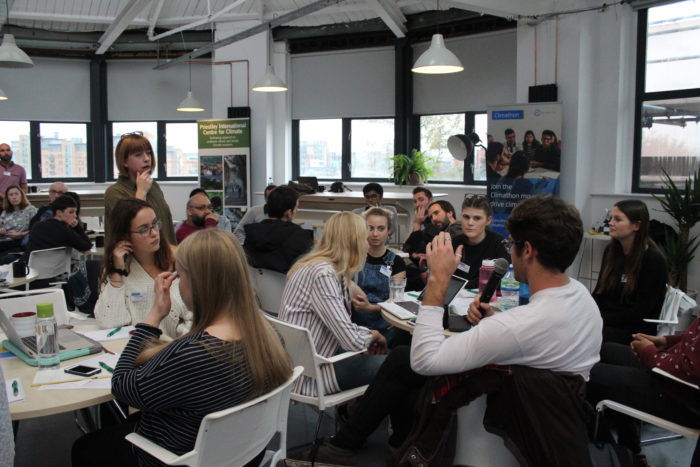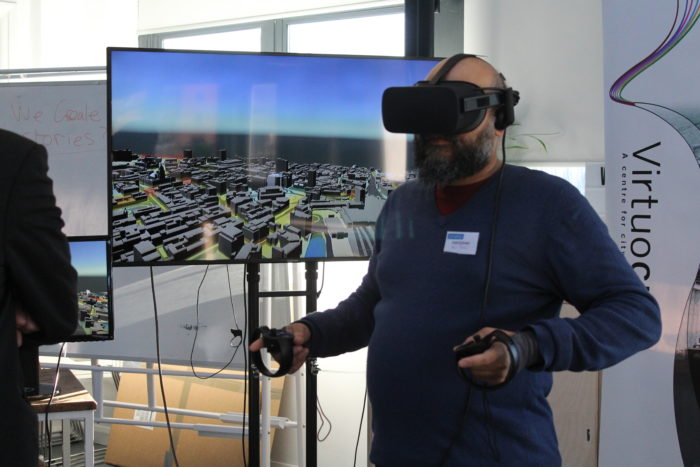Leeds Climathon produces winning solutions for air quality

With a report revealing air in 44 UK cities is too dangerous to breathe published this week, our Leeds Climathon challenge on air pollution could not have been more timely – or more needed.
Air pollution causes many chronic health problems, particularly respiratory and cardiovascular, and is also linked with cancer, strokes and dementia. Particulate matter, in the form of tiny PM2.5s, are especially dangerous as they penetrate deeper into the lungs than the larger PM10 particles (such as black carbon or ‘soot’), and ultra-fine particles may even enter the bloodstream. (Find out more about air pollution terms in this podcast we contributed to.)
The invisible pollutants contribute to 40,000 premature deaths a year nationally, with a social cost of £22.6 billion. In Leeds, almost 700 premature deaths are attributed to air pollution annually and the cost is £480 million. While PM2.5s have been reduced to WHO safety levels (10 µg/m3) in central Leeds since the 2013 data used in the Royal College of Physicians and the Lancet Countdown report, nitrogen dioxide levels are above EU levels of 40 µg/m3 in several locations and are a serious issue.
Leeds is one of five UK cities outside London required by the government’s Clean Air Plan to have a clean air zone before 2020. Congestion charging is to be considered a last resort. The pressure – legal, financial, economic and social – to come up with and implement solutions provided the framework for our learning across the two-day Climathon at ODI Leeds on 26-27 October.
A global climate challenge
Climathon is a global movement promoted by Climate-KIC and is now in its third year and growing fast. One hundred and four cities from 45 countries over six continents took part simultaneously, with seven cities in the UK (London, Leeds, Manchester, Edinburgh, Bangor, Bristol and Glasgow). Cities sign up individually to take part in the 24-hour “hackathon”, which is designed to tackle an urban climate-related challenge (there are four themes, but the cities set their specific challenge) and to stimulate innovation and entrepreneurship in the creation of solutions.
The Priestley International Centre for Climate played a key role in organising the 2017 Leeds Climathon, this time partnering with the newly formed Leeds Climate Commission and the University of Leeds’ Cities theme. Having done the 24-hour event last year, we decided to run ours over two 12-hour days instead, to maximise effectiveness and attract external groups and stakeholders. It was a bigger commitment for the participants, but it seemed to work: last year we had 29 participants (mostly University of Leeds students) and only half stayed the course; this year it proved so popular that we had to cap the numbers and a much larger and more diverse number of externals, including some professionals, took part. Inevitably there were dropouts on the day (mostly due to illness) but it produced five dedicated teams with five great proposals and 29 people finished.
With air pollution being such a pressing issue for Leeds, it was important to relate it to the global climate theme of the hackathon and link it with reducing emissions from transport. Dr Toby Hillman, one of the authors of the Countdown 2017 report, underlines the relationship, saying, “This is a really direct and tangible effect on UK health from the drivers of climate change and taking action on air quality should be a priority” (Independent). The report recommends a “robust and comprehensive policy package” including an expansion of clean air zones, a mandate for charging zones in the most polluted cities and increased investment in active transport by 2020, including safer road design and measures to increase walking, cycling and public transport use.
Tackling air quality in Leeds
Leeds City Council, which set our Climathon challenge, wanted us to look at non-charging options for tackling air pollution, reducing greenhouse gas emissions and improving air quality in the city for all. The council has worked closely with the University of Leeds partners on the challenge, with Dr Tom Knowland, Head of Sustainable Energy and Climate Change, being involved throughout the event and its planning and Councillor Al Garthwaite, who has climate change in her portfolio, introducing the Climathon and returning to take part as a judge.
In its role as an interdisciplinary centre for climate research, the Priestley Centre was able to pull together a wide range of support for the Climathon, especially from the Institute for Transport Studies, Cities theme and the Centre for Enterprise and Entrepreneurship Studies. Having it over two days also allowed us to introduce short bursts of learning from academics specialising in subjects from atmospheric composition (Dr Steve Arnold and Dr Jim McQuaid) to community engagement (Dr Katy Wright), urban green spaces (Dr Cat Scott), air pollution monitoring (Dr Pete Edwards), business models (Dr Richard Tunstall) and the application of virtual reality technology (Erik Thomasson and Prof Richard Romano of VirtuoCity).
We also welcomed external speakers on a range of other relevant topics, including: the legal situation (Alison Ogley, partner with Walker Morris LLP, which is also active on Leeds Climate Commission); sustainable transport (Lee Thompson of Sustrans); enterprise and gamification (Cristian Parrino, CEO and founder of Greengame); refrigerated transport (Etienne Teyssandier of Dearman); reducing emissions from fleets (Rick Lomax, via Skype, of the NHS Sustainable Development Unit) and an overview of Leeds air quality data (Dougie Phillips of ODI Leeds and James Hulme, Leeds City Council Sustainable Energy & Climate Change team).

As well as hearing from the experts, our teams got to do some practical work. Having been thoroughly briefed by Jim McQuaid and Cat Scott, each team was given an air monitoring kit and set off around Leeds to check out the levels for themselves, which revealed predictable spikes near passing vehicles, demonstrating the need to choose less congested routes and stand back from traffic at junctions). In a separate activity, Katy Wright also challenged them to go out and talk to members of the public about air pollution (with surprising results; some people were not well informed or particularly concerned). The following day, after one-minute pitches, facilitator Servane Mouazan got the teams outside again to gauge reaction to their prototypes.
We also gave the teams the chance to experience VR technology as a means of visualising air pollution, using a virtual model of Leeds developed by Arup with a programme being developed by PhD researcher Jack Brookes from the School of Psychology at the University of Leeds working with the Institute for Transport Studies showing levels of pollution as different colours. Participants were able to “walk” around the city at street level and choose less polluted routes. A pedestrian simulator (from VirtuoCITY) was also available, creating a more immersive experience.

The teams
After two long days of intensive work, the five teams presented their prototypes to our panel of judges Cllr Al Garthwaite, Dr James Tate (Institute of Transport Studies and an expert on air pollution) and Neil Walmsley of Climate-KIC UK and Ireland. Each team was given five minutes to present their solution and five minutes to answer questions from the panel. The teams were:
- The Green Owl Initiative (Freya Smeets, Holly Teschner and Alice Garvey): a public engagement campaign using a series of owl statutes as educative installations across Leeds that would also function as air quality monitoring units. An “OwlProwl “ trail would be launched as part of a Clean Air festival with legacy projects including air quality bulletins on electronic billboards and an eco-accreditation scheme.
- Commuter Bubble (Ben Barrett, Rohan Patel, Ella Watson, Natalie Espelid and Rashed Alawadhi): a technological solution using a titanium dioxide covered organic structure that removes a range of pollutants from the air. The honeycomb structure could be made into a fence to reduce emissions on Otley Road in Leeds; the special paint could also be applied to canvas/fabric that could cover buildings and carry advertising.
- Plants for Pollution (Ana Gallardo, Lucia Southworth and Charlie Page): vertical garden installations and moss framed billboards that would absorb pollution, beautify the city, enhance its reputation and improve wellbeing. A council owned multi-storey car park was suggested as a striking pilot, with smaller installations on roundabouts across the city.
- Be a Stop Idol (Dennis Stepan, Mick Bradley, John Castle, Paul Redgrave, Rachel Hartshorne, Bill Walton, Chris Fishlock, Caroline Tomes, Hana Pearce, Ai Van Kok, Dylan Brown, Josh Hadfield, Myra Rowland): a ‘nudge’ awareness campaign that grew out of Healthy Air Leeds to reduce engine idling by encouraging drivers to switch off their engines when stationary. The solution includes an updated traffic light at junctions that counts down to the red light change, allowing the driver to assess the time available for them to switch off their engines, and an education campaign with schools.
- AirLert (Vishnu Sunil, Reshmy Prasad, John Upton, James Spilsbury, Amzir Boodoo): combines decentralised, low-tech air pollution monitors mounted on buses feeding information to an app that can be used to inform route choices, with targeted alerts for health enthusiasts (eg runners) and vulnerable groups (eg asthma sufferers).
Results
The teams faced tough questioning from the judges, who challenged them on their technical performance, business models and feasibility. All the teams were complemented on their innovative ideas and while the judges would have liked to have found a way of combining all of them, two were picked as joint winners: Plants for Pollution and Be a Stop Idol. These two have been invited by Cllr Garthwaite to present their solutions to Leeds City Council’s State of the City event in December, at which all 99 council members and many stakeholders will get together to discuss air pollution.

To ensure a legacy for all the projects, members of the Leeds Climathon team are hoping to buddy up all five teams with researchers/organisations/mentors to assist them in further developing their ideas. Leeds Climate Commission is also keen to be use the Climathon to encourage wider discussion about, and participation in air quality solutions, and both the Priestley Centre and the Institute for Transport Studies are involved in offering support to some of the teams. A post-Climathon get-together is also being organised to reunite the teams, get updates and inspire progress.
Leeds was not the only city to set an air pollution challenge for its Climathon; Recife in Brazil, Hong Kong, Berlin, Ahvaz and Tehran in Iran, Warsaw, Mexico City and Yerevan in Armenia all set similar challenges. In the spirit of Climathon, we will be comparing our solutions with theirs in the hope that this global movement to tackle urban climate issues can produce new ideas that will benefit all.
Kate Lock, Priestley International Centre for Climate
This blog has been updated to include new data
Read about the Leeds Climathon in Yorkshire Voice
See the report on Made in Leeds TV (from 4.00-5.30 mins)
